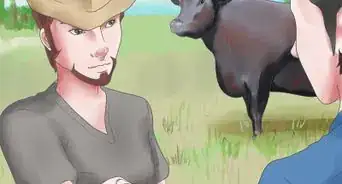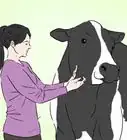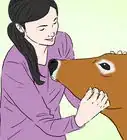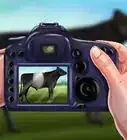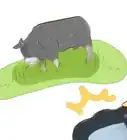This article was co-authored by Karin Lindquist. Karin Lindquist earned a BSc in Agriculture as an Animal Science major from the University of Alberta, Canada. She has over 20 years of experience working with cattle and crops. She's worked for a mixed-practice veterinarian, as a sales representative in a farm supply store, and as a research assistant doing rangeland, soil, and crop research. She currently works as a forage and beef agriculture extension specialist, advising farmers on a variety of issues relating to their cattle and the forages they grow and harvest.
This article has been viewed 206,352 times.
This is a guide to help you understand the different physical characteristics that make each bovine breed unique so that you can make the proper judgement on what breed a bovine may or may not be.
Steps
-
1Start by typing in "Cattle Breeds" in a search engine like Google or Yahoo!. You will find many different links of pages that have many different cattle breeds, from Oklahoma State University's Breeds of Livestock website to discovering many common cattle breeds at CattleToday.com and on TheCattleSite.com.
-
2Study the pictures of each of the breeds you come across and take note of the following:[1]
-
Colouration
- This will involve a description of not only the various colours that an animal of a certain breed can come in, but also the location of where most of these colours occur, whether it's varied, or in a certain location like the black or red points found on British White, American White Park and Ancient White Park cattle.
-
Body type and characteristics
- This often includes hair type (short and sleek or long and shaggy), muscling tendencies and frame size in comparison with other similar breeds, length of leg and/or body in relation to body/leg size, and the average weight of both cows and bulls. This section also tells you if the breed being referred to is dairy or beef or both.
- Remember that dairy cattle tend to be more angular- and thinner-looking with a more defined and larger udder (in cows only). Beef cattle tend to be more blocky and muscular than dairy cattle, with a seeming more rounded appearance, but at the same time not fat-looking (however there can be exceptions: see How to Judge Body Condition Scores in Cattle for more).
- This often includes hair type (short and sleek or long and shaggy), muscling tendencies and frame size in comparison with other similar breeds, length of leg and/or body in relation to body/leg size, and the average weight of both cows and bulls. This section also tells you if the breed being referred to is dairy or beef or both.
-
Head characteristics
- This includes whether the breed can be horned or polled or both and the length and size of the horns (if any), the size of the head in comparison to the body, length of the face, and coarseness/fineness of the head.
-
Other characteristics
- Often a brief history lesson and where the breed originates from is put into here, as well as the characteristics that make the breed what it is today. Such qualities as maternal qualities (e.g., milking ability, mothering ability and calving ease) and terminal/marketing traits (e.g., carcass characteristics and muscling) are mentioned.
Advertisement -
Colouration
-
3There are specifically two different types of breeds in the world: these are Dairy and Beef breeds. Cattle that are dual-purpose breeds like Red Polls, Dexters and Devon cattle, to name just a few, may be put into the beef category, seeing as they are not specifically dairy cattle but have the looks of a typical beef animal.
- Dairy breeds include Holstein-Friesian, Jersey, Guernsey, Brown Swiss, Milking Shorthorn, Ayrshire, Dutch Belted, Canadienne, and Randall.[2]
- Most North American cattle producers have a criteria for differentiating the different types of beef breeds. There are four types of beef breeds to remember: Continentals, British-type, Composites, and Exotics. This is because there are a large number of beef breeds that have originated from Great Britain (or the UK, as some of you may call it), and just as many other beef breeds that have originated from other European countries like Germany, France, Switzerland, Spain, Italy, and the Netherlands. There are also a large number of beef breeds that have been developed by crossbreeding other breeds with each other to get composites with better characteristics than their parent breeds. This has and is being done in North America, South American, Australia, and Africa. Exotics are those breeds that are either not the main-frame of a country's dairy or beef industry, or have just been introduced into a country.[3]
- British-breeds include such breeds as Angus, Red Angus, Herefords, Devons, Dexters, British White, Ancient White Parks, South Devons, English Longhorns, Scottish Higlands Galloway and Belted Galloways, Welsh Blacks, Red Polls, and Shorthorns.[4]
- Continental breeds include Limousins, Charolais, Simmentals, Maine Anjou, Gelbvieh, Blonde d'Aquitaine, Chianina, Marchigiana, Piedmontese, Belgian Blue, Pinzgauers, Romagnola, Aubrac, and Salers.[5]
- Composite breeds include Beefmaster, Santa Gertrudis, Brangus and Red Brangus, Barzona, Bonsmara, Droughtmasters, Senepols, Brahmousins, Beefmakers, South Polls, Santa Cruz, Black Herefords, Texons, Beefalo, Rangers, American cattle, Hays Converters, Speckle Parks, Braford, Simbrahs, Bralers, American White Parks, Amerifax, Salorns, Murray Grey, Mandalongs, Luing, Chiangus, Charbray, Gelbray, Buelingos, Square Meaters, RX3 and Black Maximizers.
-
Exotic breeds in North America include Dexters, Ankole-Watusi, Florida Cracker/Pineywoods, Corrientes, and even Texas Longhorns. They can also include British Whites and American White Parks, English Longhorns, Dutch Belted and Highland cattle. [6]
- It is interesting to note that all the cattle that are in North America were considered exotics, from the Spanish longhorns that first arrived in the early 16th century, to the American Brahman that were first introduced or created in the mid- to late-19th century. In today's North American cattle industry, though, the term more often refers to those breeds that are not a conventional beef nor dairy animal. However, the term "exotic" can be quite blurred and marred to the point where there really is no definite definition, and can refer to pretty well any breed in any country.
-
4Compile all these different factors and physical characteristics together to identify each breed. Once you have memorized them enough, you will know, off-by-heart, what breed each animal will be.
Community Q&A
-
QuestionWhat cross breed cow is a black cow with a white face?
 Community AnswerIt could be a Hereford/Angus cross, or any black cattle bred with a Hereford.
Community AnswerIt could be a Hereford/Angus cross, or any black cattle bred with a Hereford. -
QuestionWhat are black cattle with a white stripe down the back, not a white band around the belly?
 KarinTop AnswererThere are three predominant breeds that match this description: Randall, Lineback, and Speckle Park.
KarinTop AnswererThere are three predominant breeds that match this description: Randall, Lineback, and Speckle Park. -
QuestionWhich breed of cow is black with a thick white stripe around the belly and the back?
 Community AnswerThere are three main breeds that look like this: Dutch Belted, Belted Galloway, and Miniature Panda cattle. You will also get cattle that have a white belt--or a partial belt--when breeding either of these breeds with non-belted cattle.
Community AnswerThere are three main breeds that look like this: Dutch Belted, Belted Galloway, and Miniature Panda cattle. You will also get cattle that have a white belt--or a partial belt--when breeding either of these breeds with non-belted cattle.
Warnings
- It is often easy to confuse one breed with another, so be careful in correctly classifying what breed[s] a bovine is.⧼thumbs_response⧽
- When going out on a field trip, view the cattle by the side of the road. Do not enter the pasture or corrals, as you could be challenged by a herd bull or a cow protecting her calf, or encounter a suspicious owner with a gun.
- And always remember, a bull or cow is still dangerous even if he/she doesn't have horns.
⧼thumbs_response⧽
Other Useful and Relevant Articles
- How to Start a Cattle Farm
- How to Choose Cattle for a Foundation Herd
- How to Start up a Beef Cow Calf Operation
- How to Start a Dairy Farm
References
- ↑ https://seradria.com/blog/how-to-identify-cattle-breeds.html
- ↑ https://www.farmanddairy.com/top-stories/how-to-identify-common-dairy-cattle-breeds/423717.html
- ↑ https://www.pubs.ext.vt.edu/400/400-803/400-803.html
- ↑ https://homesteadontherange.com/2017/11/28/british-and-continental-cattle-breeds/
- ↑ https://homesteadontherange.com/2017/11/28/british-and-continental-cattle-breeds/
- ↑ https://seradria.com/blog/how-to-identify-cattle-breeds.html
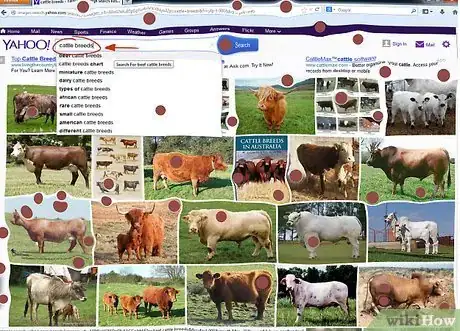
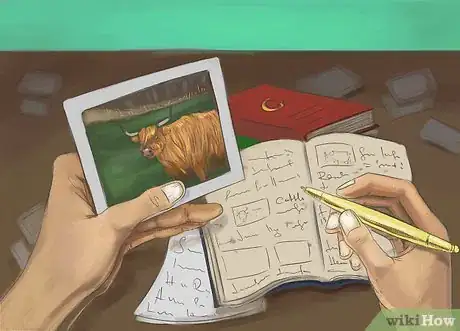
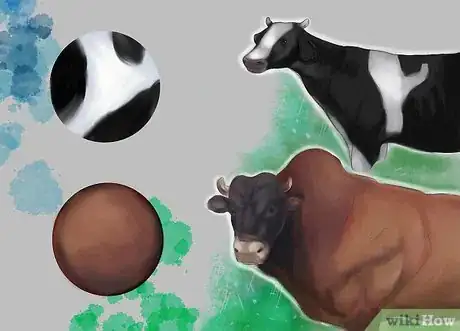

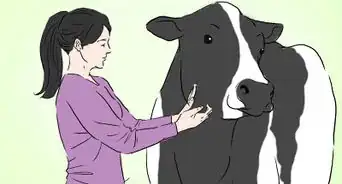
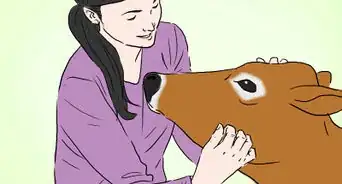
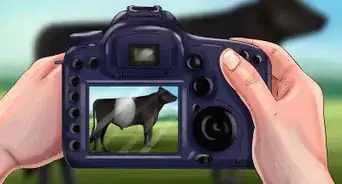
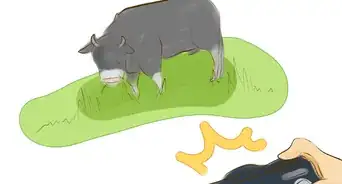
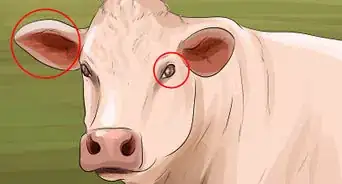
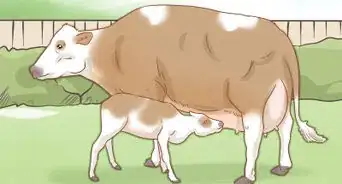
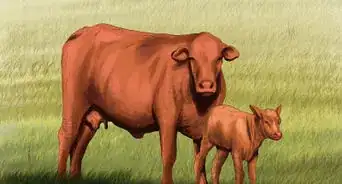
-in-Cattle-Step-6.webp)
